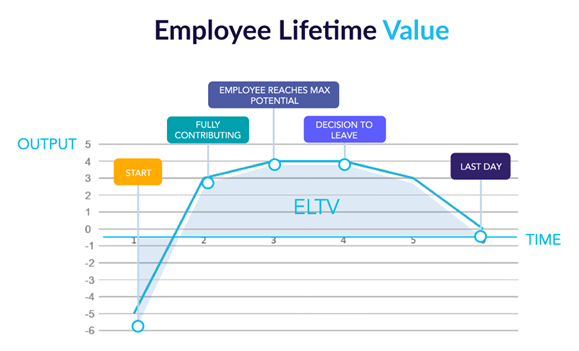7 Key Ways to Boost your Employee Lifetime Value
 We’ve all heard the quote ‘people are your most important asset’ for decades now in business, but what does it mean? The employee lifetime value (ELTV) is a relatively new measure of a hires expected future value generation during their time in a company; and it aims to quantify and back this statement up with data. Essentially, an employee with a high ELTV has a positive impact on the business outcomes, as the employees truly bring value to the company.
We’ve all heard the quote ‘people are your most important asset’ for decades now in business, but what does it mean? The employee lifetime value (ELTV) is a relatively new measure of a hires expected future value generation during their time in a company; and it aims to quantify and back this statement up with data. Essentially, an employee with a high ELTV has a positive impact on the business outcomes, as the employees truly bring value to the company.
Designing for impact allows you to specifically optimise employee performance and result in maximum results. The greater the experience throughout an employee’s tenure at your company, the more likely it is they will perform and contribute maximum value to your organisation.
This article looks at 7 key areas of focus to boost and foster high ELTV at your organisation.
What is employee lifetime value?
Employee lifetime value (ELTV) refers to the expected future value of an employee’s time in an Company. A high employee lifetime value. ELTV is quite similar to a concept in marketing known as customer lifetime value (CLV or CLTV) – an economic value that the customer brings to the business. This is not a measure of just one purchase of a customer but a customer’s value across the whole relationship. Similarly, the value of an employee’s contributions is measured across the entire working relationship and duration. Its influenced by a range of factors including onboarding, training and development, recruitment, management practices, employee value propositions and employee experience.

What can you do to boost employee lifetime value?
Improving your people practices goes a long way in boosting the employee lifetime value at your company. Here are just some of the ways HR Optimisation encourage our clients to grow their ELTV:
- Build a strong recruitment and selection process – Employees who are the right fit for your company and vice versa are more likely to stay with you longer but also be more productive and perform better. A good recruitment process requires you to have a solid employee value proposition. You need to couple this with a smart sourcing strategy and a clear vision of the type of candidates you want to attract. Before sourcing, create a profile of the ideal candidate and start sourcing and recruiting on this basis.
- Focus on onboarding– A high-quality onboarding process that starts with pre-boarding and job orientation helps accelerate employee productivity. In a work environment that is becoming increasingly remote, be sure to keep personal touches, like making use of video for a face-to-face introduction. Focus on automating the administrative tasks needed to get an employee onboarded (technology, paperwork, equipment, etc.) so that you can focus on the essential things. That is, opportunities to meet with colleagues and with relevant stakeholders.
- Invest in targeted training– targeted skills and knowledge training, management and leadership development and dedicated learning time all of that will help you improve ELTV. Where covid rules permit – adopt a blended approach (digital & classroom) to learning. However, the most important aspect is to develop a culture of learning from the top-down. Lots of businesses have access to a plethora of resources, but much of it goes unused. If you purposefully create space and time for these activities, then learning becomes more effective, and the value of the contribution by your workforce increases.
- Develop your managers– We’ve all heard that employees don’t leave jobs; they leave managers. To develop your managers in a way that they can help their employees perform their best, feel appreciated and motivated and stay within your employment. The more developed managers are, the greater the ELTV is for all employees.
- Work on your employee experience– Throughout the employee life cycle, focus on the moments that matter. Organizations with a higher employee net promoter score (eNPS) are likely to have higher-performing employees, resulting in more revenue and productivity. It’s important to understand that each individual is different, and thus their employee experiences require tailored solutions.
- Build an inclusive company culture– where equality, diversity and inclusion is championed and your employees feel valued, respected, and appreciated. Diversity leads to greater ideas and innovation, which, in turn, creates more opportunities for employees to be given ‘stretch projects’ – where they are challenged by the complexity of the work and not the amount of work. Individual employees’ contributions, in this way, are more optimised than ever.
- Have solid compensation and benefits strategy– When employees feel they’re being fairly and competitively rewarded for the work they’re doing, they’re going to be more motivated, engaged, and likely to stay. This requires a comprehensive compensation and benefits outlook to remain competitive in the market and also retain your top talent.
Summary
Employee development, focus on employee retention, and good employee experience are key to increasing employee lifetime value, which in turn, has a positive impact on the bottom line. Even small changes to HR practices can make good incremental ELTV improvements. For example, in many instances, small improvements in an onboarding process can deliver up to a 6x difference in ELTV for an employee.
HR Optimisation are experts in designing an embedding a people plan to boost client’s employee lifetime value – why not reach out for a free no obligation chat and see how we can help you secure the maximum engagement, productivity and value of your employees?

Hannah Powell
Categories
- Coaching (9)
- CSR (1)
- Culture (1)
- Culture & Engagement (33)
- Diversity and Inclusion (16)
- Employment law (38)
- Inspiration (12)
- Leadership (14)
- Learning & Development (7)
- Recruitment (12)
- Reward (9)
- Self-development (2)
- Tips & tricks (11)
- Uncategorized (18)
- Welfare and Wellbeing (26)
